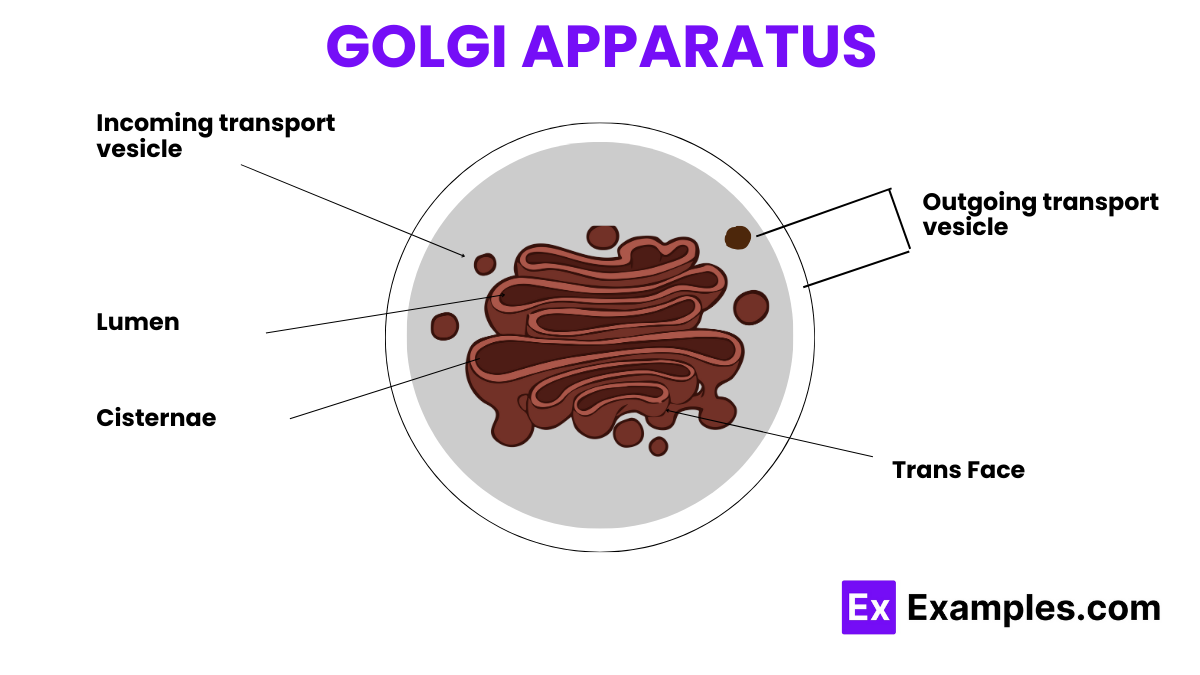What is the primary function of the Golgi apparatus?
Protein synthesis
Energy production
Modification, sorting, and packaging of proteins and lipids
Genetic information storage


The Golgi Apparatus, often termed the cellular post office, plays a pivotal role in modifying, sorting, and packaging proteins and lipids for secretion or use within the cell. This organelle consists of a series of flattened, stacked pouches called cisternae. It is essential for processing the macromolecules synthesized in the endoplasmic reticulum and preparing them for their specific destinations. Through examples such as the secretion of hormones, the production of lysosomes, and the glycosylation of proteins, this guide illuminates the Golgi Apparatus’s crucial functions. Its role in diseases like Alzheimer’s, where protein misprocessing occurs, further highlights its significance.
The Golgi apparatus, often referred to as the Golgi complex or Golgi body, is a critical organelle found in most eukaryotic cells. It functions primarily as a central hub for modifying, sorting, and packaging proteins and lipids that have been synthesized in the endoplasmic reticulum (ER). Structurally, the Golgi apparatus is composed of a series of flattened, membrane-bound sacs known as cisternae, which are organized into three main regions: the cis-Golgi (nearest the ER), the medial-Golgi, and the trans-Golgi (furthest from the ER). Proteins and lipids enter the Golgi apparatus at the cis face, where they undergo initial modifications such as phosphorylation or glycosylation.
The Golgi apparatus, often referred to as the Golgi complex or Golgi body, is a critical organelle found in most eukaryotic cells. It is composed of a series of flattened, stacked pouches called cisternae. These membranous structures are arranged roughly parallel to each other, creating a ribbon-like assembly that is often compared to a stack of pancakes. The number of cisternae in a Golgi apparatus can vary depending on the cell type, ranging from a few to several dozen.
The Golgi apparatus is polarized, consisting of two distinct sides: the cis face and the trans face. The cis face, also known as the “receiving” or “entry” side, is located near the endoplasmic reticulum (ER) from which it receives newly synthesized proteins and lipids. The trans face, on the other hand, is known as the “shipping” or “exit” side, from which processed and packaged molecules are dispatched to their final destinations within or outside the cell.
Between the cis and trans faces are the medial cisternae, where most of the processing and modification of molecules occur. This internal region of the Golgi apparatus is rich in enzymes that modify proteins and lipids, including the addition of carbohydrate groups (glycosylation), the removal of certain amino acids, and the sulfation of lipids and proteins.
The Golgi apparatus serves as a central hub for processing, packaging, and sorting proteins and lipids that are synthesized in the endoplasmic reticulum. Its functions include:
Golgi bodies, integral components of the cell’s endomembrane system, perform several critical functions that are essential for the cell’s operation and maintenance. Here are their key functions:
The Golgi apparatus was discovered in 1898 by Italian scientist Camillo Golgi, using his pioneering staining technique.
In microscopic images, the Golgi apparatus doesn’t have a specific color but appears pink or orange when stained with osmium tetroxide.
In essence, the Golgi apparatus serves as the cellular post office, expertly handling the packaging and dispatching of molecular cargo. It ensures that proteins and lipids are correctly modified, sorted, and delivered to their precise destinations, maintaining the cell’s functionality and health. Its strategic operations underscore its indispensable role in cellular biology, contributing to the intricate dance of molecular interactions that sustain life.
Text prompt
Add Tone
10 Examples of Public speaking
20 Examples of Gas lighting
What is the primary function of the Golgi apparatus?
Protein synthesis
Energy production
Modification, sorting, and packaging of proteins and lipids
Genetic information storage
Which organelle works closely with the Golgi apparatus to transport proteins?
Mitochondria
Endoplasmic Reticulum (ER)
Nucleus
Lysosome
The Golgi apparatus is primarily found in which type of cells?
Prokaryotic cells
Eukaryotic cells
Both prokaryotic and eukaryotic cells
Viruses
What are the flattened membrane-bound sacs in the Golgi apparatus called?
Cristae
Thylakoids
Cisternae
Vesicles
Which of the following describes the pathway of a protein through the Golgi apparatus?
ER → Golgi → Nucleus
ER → Golgi → Plasma Membrane
Nucleus → Golgi → Mitochondria
Golgi → ER → Plasma Membrane
The Golgi apparatus is involved in the formation of which of the following cellular structures?
Ribosomes
Lysosomes
Mitochondria
Chloroplasts
Which process is the Golgi apparatus NOT directly involved in?
Glycosylation of proteins
Lipid metabolism
DNA replication
Production of secretory vesicles
The 'cis' face of the Golgi apparatus is oriented towards which organelle?
Nucleus
Plasma membrane
Endoplasmic Reticulum (ER)
Lysosome
What is the main difference between the 'cis' and 'trans' faces of the Golgi apparatus?
Shape
Function
Location
Both B and C
Which molecule is commonly added to proteins by the Golgi apparatus to form glycoproteins?
Lipids
Nucleotides
Carbohydrates
Amino acids
Before you leave, take our quick quiz to enhance your learning!

